The Untamed North - 2016
Greenland
Here are the bare bones of our Greenland adventure.
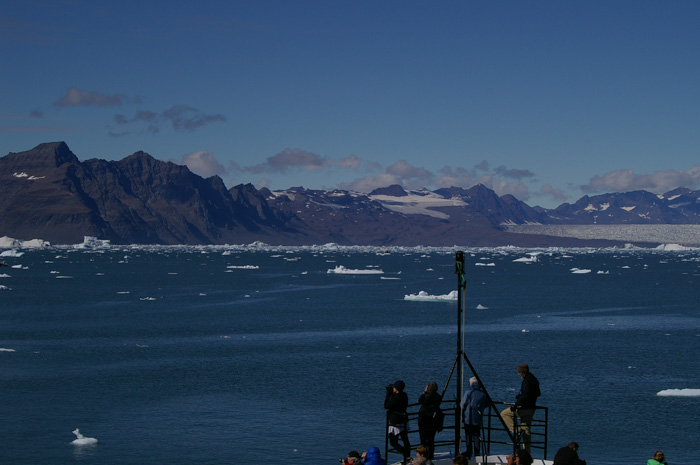
Our passage to Greenland took overnight and much of the following day. There was never much downtime, however. If we weren't exploring in the Zodiacs, taking in the magnificent scenery or watching for wildlife, chances are there was an informative and entertaining lecture by the expedition staff.
The first place we visited was Nansen Fjord on the east coast. It is named for the great Fridtjof Nansen, scientist, polar explorer, humanitarian, diplomat and recipient of the 1922 Nobel Peace Prize.
One of the marine mammals that we had been told not to expect in Greenland was the polar bear. In this one fjord we saw about a dozen including a mom and her two cubs! Even though you couldn't prove it by us, the polar bear population is declining due to environmental pollution and loss of critical sea ice habitat due to warming sea temperatures.

The following day saw us in Skaergaard Fjord, the location of the Skaergaard Intrusion. Our geologist, Tom Sharpe, was beside himself with enthusiasm. He told us to be sure and let our geologist friends back home know that we had been here ... and watch them turn green with envy.
Not being a geologist, I'll let the link above tell about the importance of this formation. I can attest that the location is very beautiful.
At all of the shore excursions, except those in towns, members of our expedition staff were posted around the area with binoculars and rifles. This was to provide protection from the odd polar bear! We were instructed to head immediately for the Zodiacs if the alarm was given. If bears had actually been seen prior to landing, it is needless to say that the landing was abandoned. This happened once or twice.
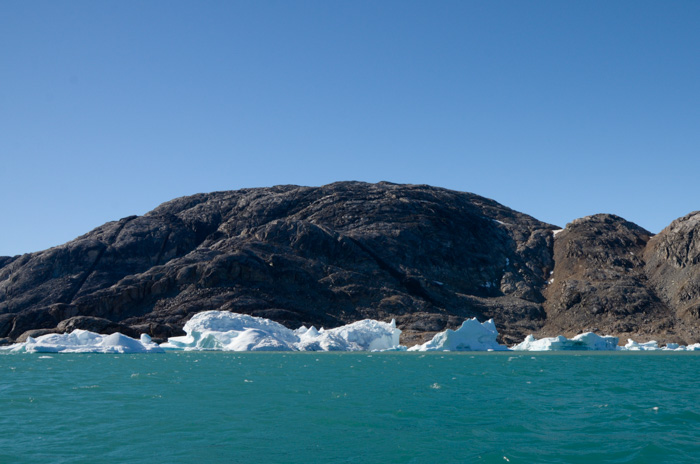
The intrusion is the darker rock shown on the left here. Adjacent older rock is lighter in color. In the picture above, we are standing on the crest of the intrusion.
Our Stanford professor, Dr. Rob Dunbar, brought a camera drone that took some very striking images clearly showing the boundaries of the intrusion as well as other sights throughout our trip.
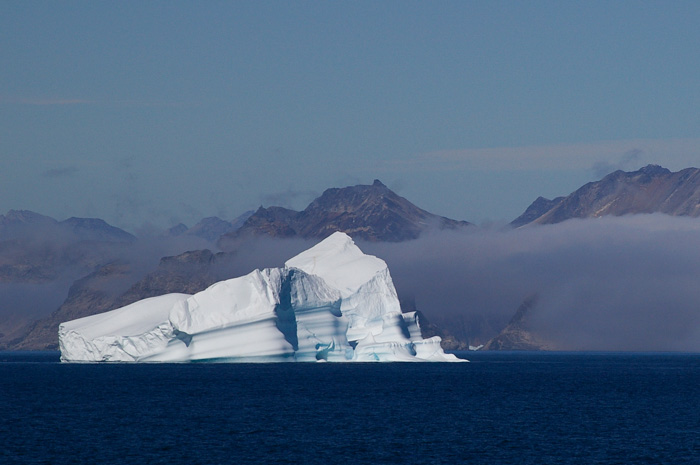
The next day saw us cruising down Greenland's east coast towards the Ammassalik fjord.
The weather remained unexpectedly clear, but we did encounter patches of fog, which sometimes closed in entirely and at other times just added to the atmospheric mystery.
Icebergs large and small were a common sight.
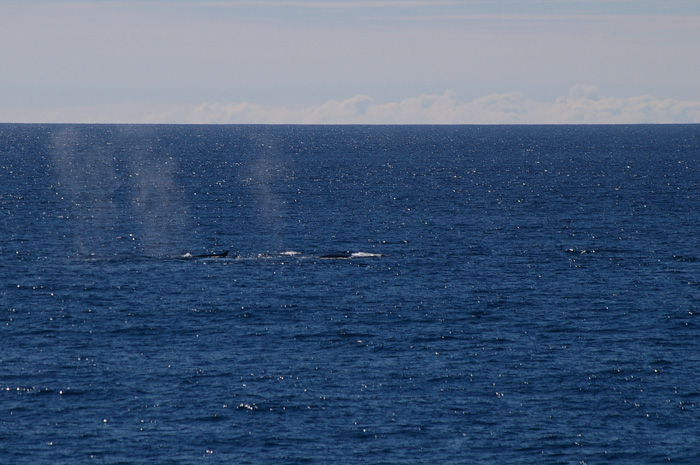
During our cruise we fell in with a pod of feeding fin whales, the second largest animal on earth after the blue whale. One of the nice things about an expedition cruise is that at all times the bridge and one or more naturalists are on the lookout for a variety of natural wonders. When something notable is seen, everything is put on hold while the passengers flock on deck to observe. We had lectures interrupted and meals delayed at various times. We were also awakened one night for a rare, at this time of year, view of the northern lights.
When there is something to watch, moreover, the bridge will circle the area for an extended period to enable everyone to get a good view.
The various whales looked similar to me. I would not have been able to tell the difference between the fin and humpback whales except that the naturalists identified them as such.
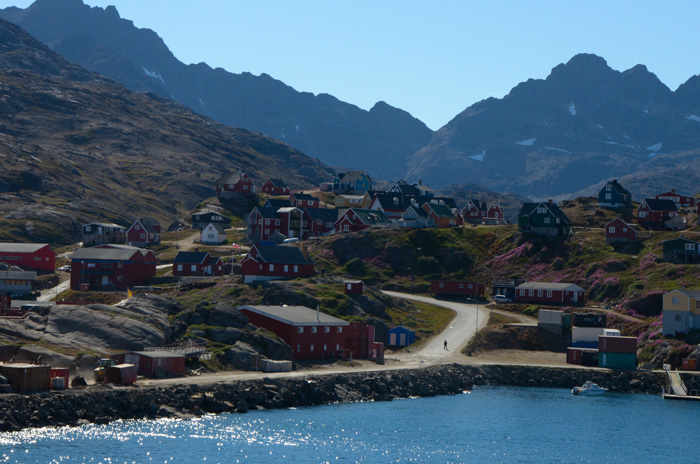
One of the expedition staff on board had been born in this town, Tasiilaq, and lived there until about ten when her parents relocated to Nuuk, the capital. This was her first time back.
All of the buildings in this and other settlements were quite colorful. We were told that at one time the color indicated the function of the building, e.g., hospitals were yellow, or the occupation of the owner, but that is no longer the case.
We had some interesting experiences here including a seal being butchered to feed sled dogs and a performance by a local folkloric choir. There was time to walk into the natural areas where children were taking advantage of the summer weather of temps in the 60s to swim in the glacial runoff river. Brrr.
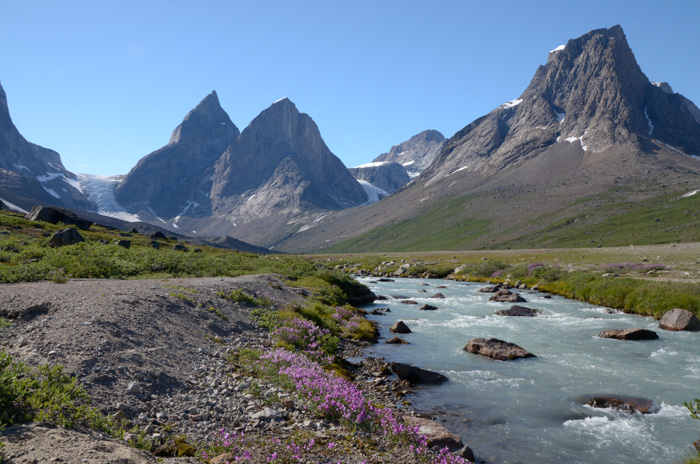
The following day on our way to Skjoldungen Fjord, we were treated to a rare sighting of sperm whales. This was one whale that I could identify. Instead of a fin, the whale has a knob on its back. The blow and the flukes are also distinctive.
The whales would spend a little time on the surface and then dive for a considerable amount of time. We were told that they can stay down for as long as an hour.
We landed on lovely Skjoldungen Island.
The original plan was to cross the river and explore some significant glacial moraines, but the river was obviously too deep and rapid to wade. Therefore we simply walked up the near bank.
On the two Zegrahm trips we've taken there are different routes for "long walkers," "medium walkers" and other less hearty folk. On this trip, over half of the participants usually joined the long walkers!
Since this was an island, after our landing, we were able to cruise out a different route out than we took in allowing for more views.
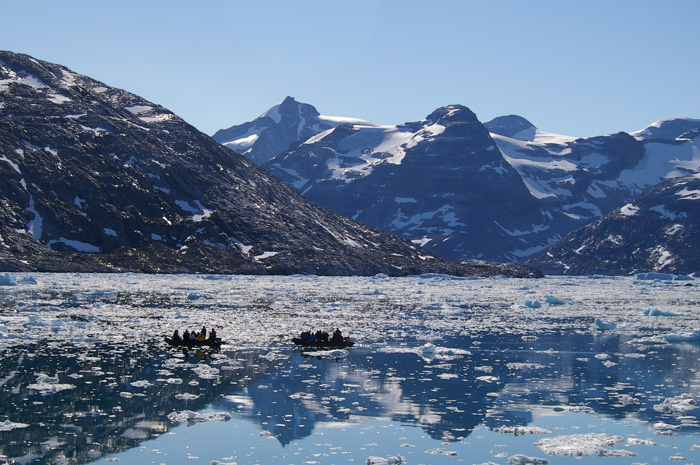
Napassorssuaq Fjord was the most breathtaking of the many majestic places we visited. Besides the drop-dead scenery and the mirror-like surface of the water, we were treated to an extensive visit by a polar bear and her cub.
I decided not to go out in the Zodiacs this day, so I didn't get as intimate with the bear as most of our travelers, but Jim and I were both enthralled by the interactions of the bears with each other and also with our Zodiacs, which kept a respectful distance, of course.
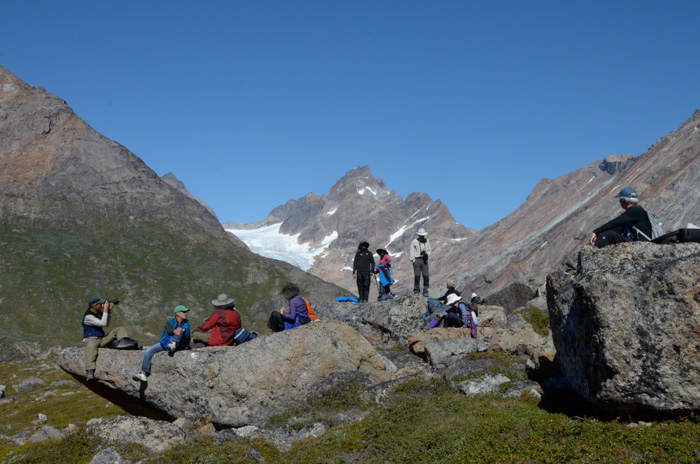
We are arriving back in the vicinity of inhabited places as we visit Prins Christian Sund. At this landing site we saw both sheep and horses. I asked about the origin of the horses at one town we visited and was told that they were Icelandic. Makes sense.
The "long hikers" have scrambled across bog and moraine to reach a vantage point up at the junction of three valleys. It was a warm day, but the vicious biting flies encouraged most folks to keep covered up. My Deepwoods Off was pretty popular.
Although Greenland is an independent Danish province, most of the place names have been changed from Danish to Greenlandic designations. I don't know why this sound was an exception. I can't find a good map online, but it snakes from the Irminger Sea on the east of Greenland to the Labrador Sea on the west like an "inland passage."
The lectures by Rob Dunbar described the cold and warm ocean currents here and throughout the world as a "conveyor belt" that affects global climate. Under certain (formerly) rare conditions this conveyor belt can stop, which has disastrous effects on the entire planet. There is concern that the global warming we are experiencing today could have this result.
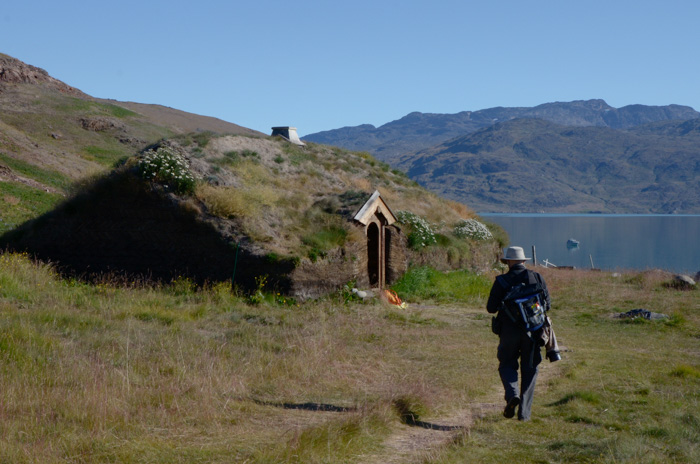
The following day we visited Brattahlið, the Norse settlement founded by Erik the Red. This was our first visit in western Greenland, which has historically been the most settled portion of the island.
Although the history was interesting and it was nice to see the archeological sites that fleshed out the reading we had done prior to the trip, West Greenland was not as majestically beautiful as the eastern fjords.
This reconstruction of a Norse longhouse, provided some insight into the way that the people lived.
There is a modern town nearby and farming has returned to Greenland. The growing season is, however, short and the major crop is hay to maintain the livestock over the winter.
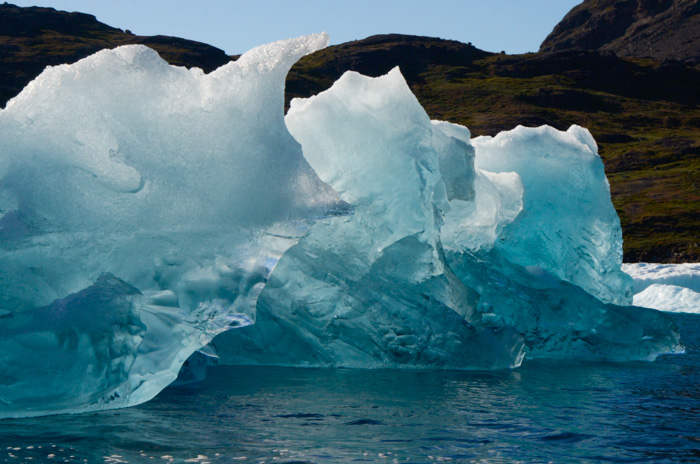
That afternoon we visited Narsaq, the site of another Norse settlement. There was a large troupe of hardy souls that undertook the four-mile hike to the unexcavated ruins. Our geologists were in seventh heaven over the rare minerals to be found on the way. The less scientific, such as myself, were just glad to have a chance for a brisk walk in the sunshine.
The sights I found most notable here were the many icebergs.
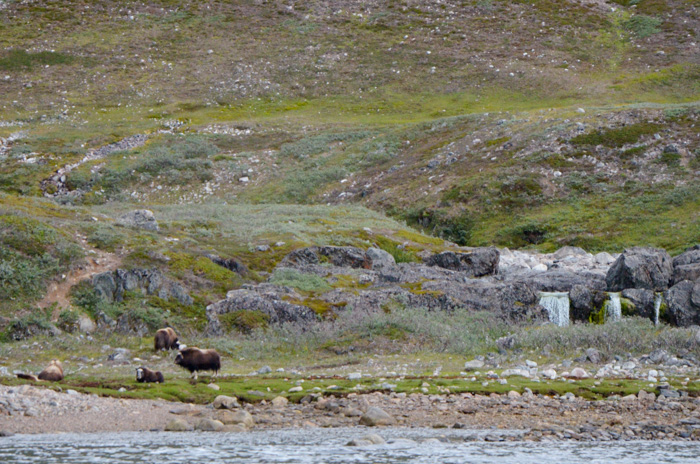
The following day our weather luck ran out. We had been blessed with sunny skies and mild temperatures throughout the trip, but this day dawned grey and dank. Soon it began to drizzle, but not before we could organize a Zodiac expedition to an area of geological wonders in Ikka Fjord. (Check out a breathtaking underwater video.) We needed to meet a guide to take us to the underwater columns, and (unlike the above video) we were admonished that it was a "wake free" zone to protect the tops of the eerie growths.
Not having an underwater camera (some in our group did), I took more photos of the resident musk oxen families relaxing on the nearby meadows.
After our morning excursion, the afternoon entertainment included watching the early documentary Nanook of the North. I had heard of this all my life, but never seen it.
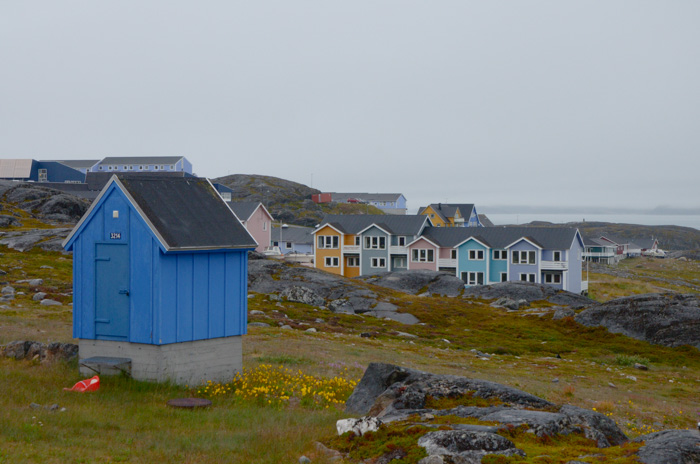
The dreary weather continued for our visit to Nuuk, the capital of Greenland.
The images at the link show a vibrant city. Unfortunately we didn't get to see that city. The low clouds and fog blocked all views of the surroundings and we didn't have enough time to see much of downtown.
We did get to see at least part of a very nice cultural and historical museum and we got the obligatory photo with our local newspaper at the downtown "you are here" sign. We've sent it in for their vacation photo series.
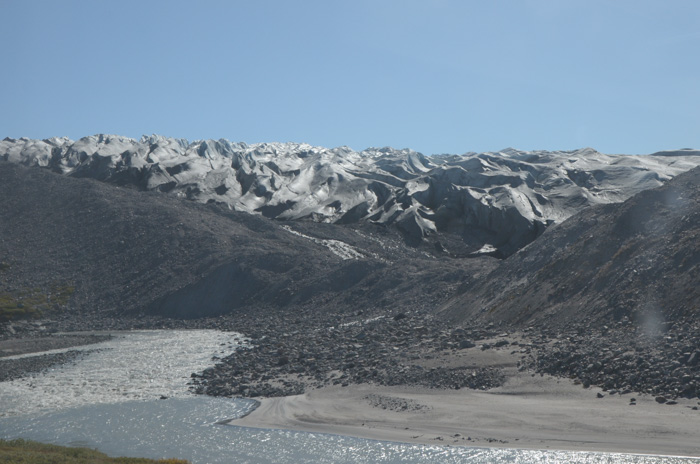
The major international airport is not at Nuuk, but almost a day's cruise away in Kangerlussuaq. While there we had enough time to make a trip to see the actual Greenland ice pack rather than its subsidiary glaciers.
We loaded into wheeled torture chambers masquerading as buses for the long journey over a washboardy road. Along the way we passed magnificent scenery, but time didn't permit a leisurely journey filled with photo ops. I managed to grab this picture, which is my favorite of the ice cap, through the scarred and dirty window.
The ice is melting precipitously. In spite of what some politicians proclaim, the true scientific consensus is that global warming is not only real, it is unprecedented in the 100Ks of years of scientific data analysis of sediment and ice cores. We learned some sobering facts on this trip, which I will cover in more detail in the full presentation.
Visiting Greenland is not like a vacation at the beach, or even a visit to the mountain parks back home, but we feel blessed by the opportunity.
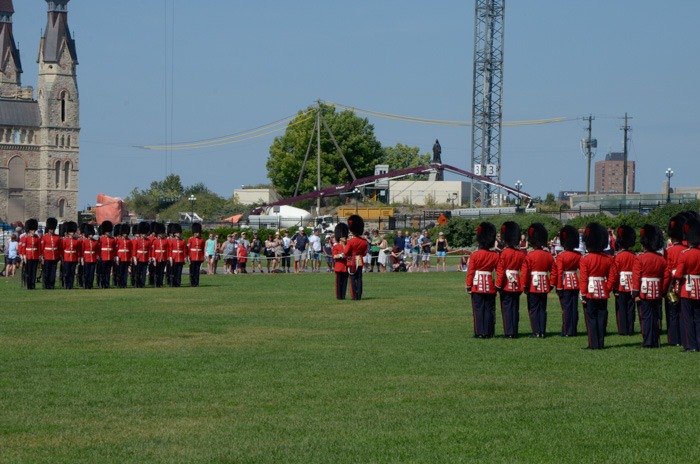
From Greenland we flew to Ottawa for an overnight stay. Jim & I, and some others elected to spend an additional night in order to see the city.
The next morning we shared a cab with another couple to the city center and arrived just in time for the changing of the guard outside the Canadian Parliament. It was filled with pomp and circumstance. In addition to the guard units, there was a band and a unit of pipers.
Construction cranes and scaffolding were everywhere in Ottawa. When we asked, we were told that next year is Canada's 150th anniversary and they were taking full advantage of the summer construction season to spruce up the city.
We enjoyed our short visit to Ottawa, but we were anxious to get home.
What a marvelous experience it all was!
Click your "back" button to return to the previous page or click for our picture album.